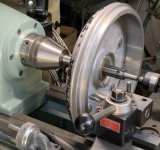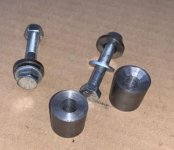rimcanyon
Diamond
- Joined
- Sep 28, 2002
- Location
- Salinas, CA USA
Wouldn’t you know it, I had a pair of brake drums to turn that were ½” too large to fit the round dial. The 49 mfg lathe has been rebuilt about a month now, while I have been working on the 59 10EE and some automotive projects, so it was a good chance to use it. Also a good chance to see how versatile it is, since I needed to turn between centers and the work needed to fit the space between headstock and turret.
Worked quite well, here are a couple photos:

The live center mounted in the turret works fine because there is a lock bolt for the turret slide.


The expansion arbor had the same number of expansion slots as the number of splines in the hub, so it worked out well and the drum was well-supported.
Next project is to make a fixture to hold the brake shoes for arcing. I have not been able to find an automotive repair shop within 100 mi. That does that work any more.
Worked quite well, here are a couple photos:

The live center mounted in the turret works fine because there is a lock bolt for the turret slide.


The expansion arbor had the same number of expansion slots as the number of splines in the hub, so it worked out well and the drum was well-supported.
Next project is to make a fixture to hold the brake shoes for arcing. I have not been able to find an automotive repair shop within 100 mi. That does that work any more.







